TU-8400 is the Successor Model of TU-8200R.
Available NOW
There are three versions
1. TU-8400 with stock OPT with ALPS R27 potentiometer + Metal Knob) $885
2. TU-8400 with Lundahl LL2777B $1,175.00
TU-8400 is designed based on EL34 x 2 + 12AX7 x1. There are only two coupling caps. You can run KT170 with TU-8400
etc..





Last edited:
Specs;
(TENTATIVE as of May 20th)
Model No. : TU-8400E/VK
Tubes : PRE: 12AX7 (ECC83, 7025) x 1pc
OUTPUT : 6V6 series, 6F6 series, etc ... LOW mode,
6L6 series, EL34(6CA7), 5881, 7581m WE350B, KT66, KT77, KT88, KT90 etc ... HIGH mode
*KT120, KT150, KT170 are also usable but they do not fit in the safety cover attached.
Circuit configurations : Vacuum tube stereo power amplifier
Output stage : A-class single ended, active automatic bias adjustment (low loss automatic bias)
Heater ON : PRE tube : AC-power
B-power : MOSFET ripple filter (Right and left channel independent)
Preamp function : An OP-amp NJM2068DD equipped in INPUT-2.
Mode : Power mode : LOW, HIGH
Output tube connection mode : Ultra Linear, Triode, Pentode
Max. output (8ohm load, THL10%, UL mode) : HIGH : 2 x 7W(6L6), 2 x 8W (EL34), 2 x 8.6W (KT88), 2 x 9.8W (KT170)
LOW : 2 x 3.3W (6V6), 2 x 2.6W (6F6)
Rated input (HIGH mode, UL, EL34) : 850mV rms (INPUT-1), 220mV (INPUT-2)
INPUT-2 preamp function gain : 11.5dB
Frequency response (-3dB, UL, HIGH) : 20 - 50,000Hz
Residual noise (IHF-A, 8ohm, UL, HIGH, EL34) : 27uV rms
Input terminal : RCA jack, Stereo 1 line (INPUT-1, 50kohm), 3-pole mini (3.5mm dia.) jack (INPUT-2, 12kohm, preamp function)
Output terminal : Binding terminal (gold-plated, banana plug usable)
Headphone terminal (3-pole standard (6.3mm dia.) jack)
Speaker impedance : 4 - 16 ohm (optimal load 6 - 8ohm)
Headphone impedance : 8 - 600 ohm (corresponds to high-impedance headphones as well), unbalanced
IEC standard 3P inlet type
Rated power consumption : 95W (HIGH mode, KT170), 71W (HIGH mode, EL34), 36W (LOW mode, 6V6)
Dimensions : W252 x H189 x D286 mm (With safety cover, including projections)
Weight : Approx.6.6kg (Assembled, excluding tubes and power cord)
(TENTATIVE as of May 20th)
Model No. : TU-8400E/VK
Tubes : PRE: 12AX7 (ECC83, 7025) x 1pc
OUTPUT : 6V6 series, 6F6 series, etc ... LOW mode,
6L6 series, EL34(6CA7), 5881, 7581m WE350B, KT66, KT77, KT88, KT90 etc ... HIGH mode
*KT120, KT150, KT170 are also usable but they do not fit in the safety cover attached.
Circuit configurations : Vacuum tube stereo power amplifier
Output stage : A-class single ended, active automatic bias adjustment (low loss automatic bias)
Heater ON : PRE tube : AC-power
B-power : MOSFET ripple filter (Right and left channel independent)
Preamp function : An OP-amp NJM2068DD equipped in INPUT-2.
Mode : Power mode : LOW, HIGH
Output tube connection mode : Ultra Linear, Triode, Pentode
Max. output (8ohm load, THL10%, UL mode) : HIGH : 2 x 7W(6L6), 2 x 8W (EL34), 2 x 8.6W (KT88), 2 x 9.8W (KT170)
LOW : 2 x 3.3W (6V6), 2 x 2.6W (6F6)
Rated input (HIGH mode, UL, EL34) : 850mV rms (INPUT-1), 220mV (INPUT-2)
INPUT-2 preamp function gain : 11.5dB
Frequency response (-3dB, UL, HIGH) : 20 - 50,000Hz
Residual noise (IHF-A, 8ohm, UL, HIGH, EL34) : 27uV rms
Input terminal : RCA jack, Stereo 1 line (INPUT-1, 50kohm), 3-pole mini (3.5mm dia.) jack (INPUT-2, 12kohm, preamp function)
Output terminal : Binding terminal (gold-plated, banana plug usable)
Headphone terminal (3-pole standard (6.3mm dia.) jack)
Speaker impedance : 4 - 16 ohm (optimal load 6 - 8ohm)
Headphone impedance : 8 - 600 ohm (corresponds to high-impedance headphones as well), unbalanced
IEC standard 3P inlet type
Rated power consumption : 95W (HIGH mode, KT170), 71W (HIGH mode, EL34), 36W (LOW mode, 6V6)
Dimensions : W252 x H189 x D286 mm (With safety cover, including projections)
Weight : Approx.6.6kg (Assembled, excluding tubes and power cord)
Yes, which is why I called it TU-8150 on steroids. The concept of using a single 12AX7 driver and an opamp comes from that amp.
Last edited:
Very intrigued by selectable (input 2 vs input 1) opamp driver stage. Opamps have made huge strides recently. Can be an excellent synergy old technology with new.
Good to have the choice.
Is the opamp upgradable to something like the Sparkos discrete?
Good to have the choice.
Is the opamp upgradable to something like the Sparkos discrete?
Possibly an optional upgrade? Something to think about anyhow.You can try Sparkos but I perfer Muse Op-amp
Looking forward to this amplifier being released.
The case looks to be the same dimensions as the 8200 that it replaces. I see brackets for what I suspect would be a Polycarbonate tube cage.
Any chance Elekit could make that cage available to retro-fit the TU-8200R ?
Any chance Elekit could make that cage available to retro-fit the TU-8200R ?
The case is made to fit KT170. It is too high for TU-8200. You can order the case for TU-8400 to retro fit for TU-8200
Translated from MR Ohashi's Blog (translated by Google translator)
Today I will report on Elekit's new product, the TU-8400, for which information has just been released by ELEKIT.
Thanks to the generosity of the manufacturer, we were able to borrow a mass-produced sample , which gave us the opportunity to thoroughly examine not only the features of this new model, but also the changes from the previous model (TU-8200R), and even compare the sound quality, so we would like to delve into this in more detail.
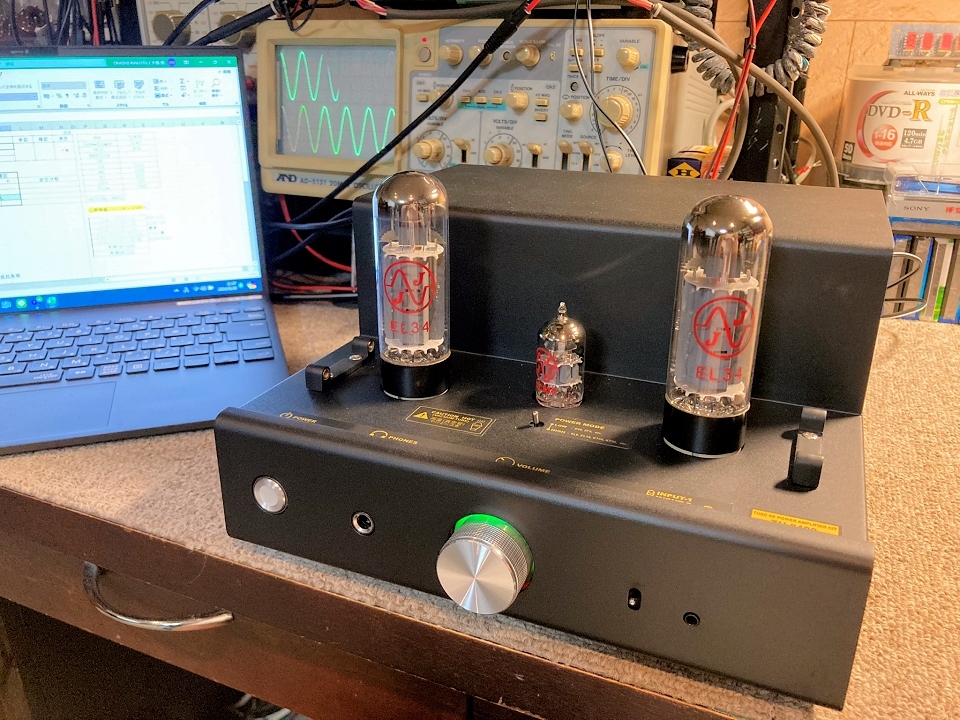
This is the TU-8400. The The black faceplate is very cool. It is a power amplifier with volume control and has one RCA input and one stereo mini plug input.
The auto-adjusting fixed bias circuit inherited from the TU-8200R allows you to enjoy adjustment-free switching with the same ease as a self-biasing amplifier. In addition, by switching the plate voltage between HIGH and LOW, it covers 6V6 and 6F6 in LOW mode, and 6L6 series, KT66, KT88, KT90, EL34, 5881, 7581, 6550, and even KT120, KT150, and KT170 in HIGH mode.
Let's start by looking at the exterior.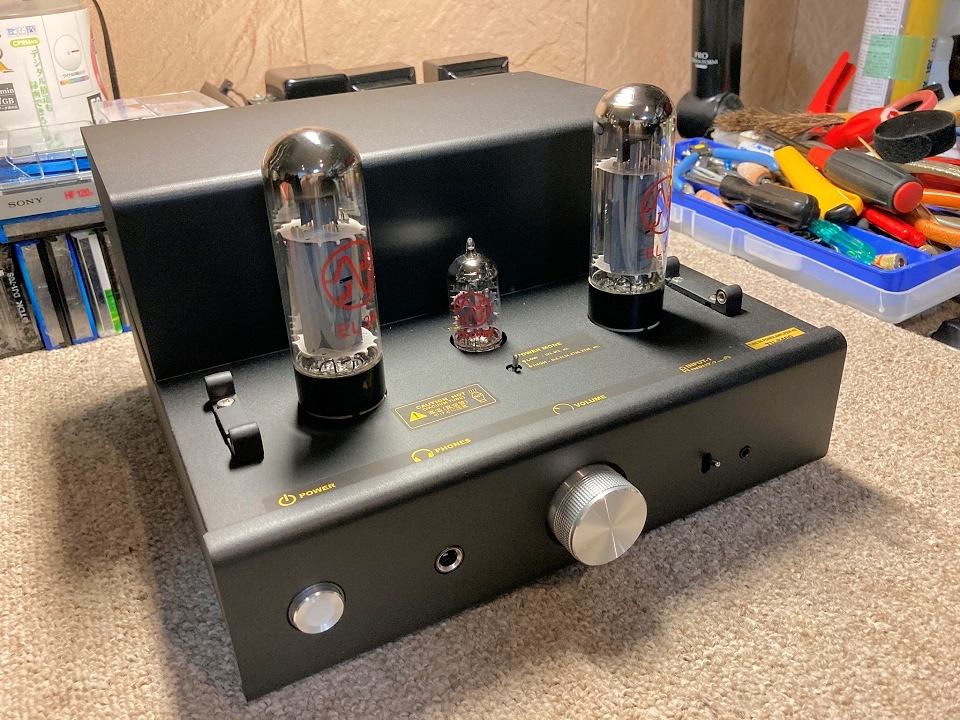
JJ EL34
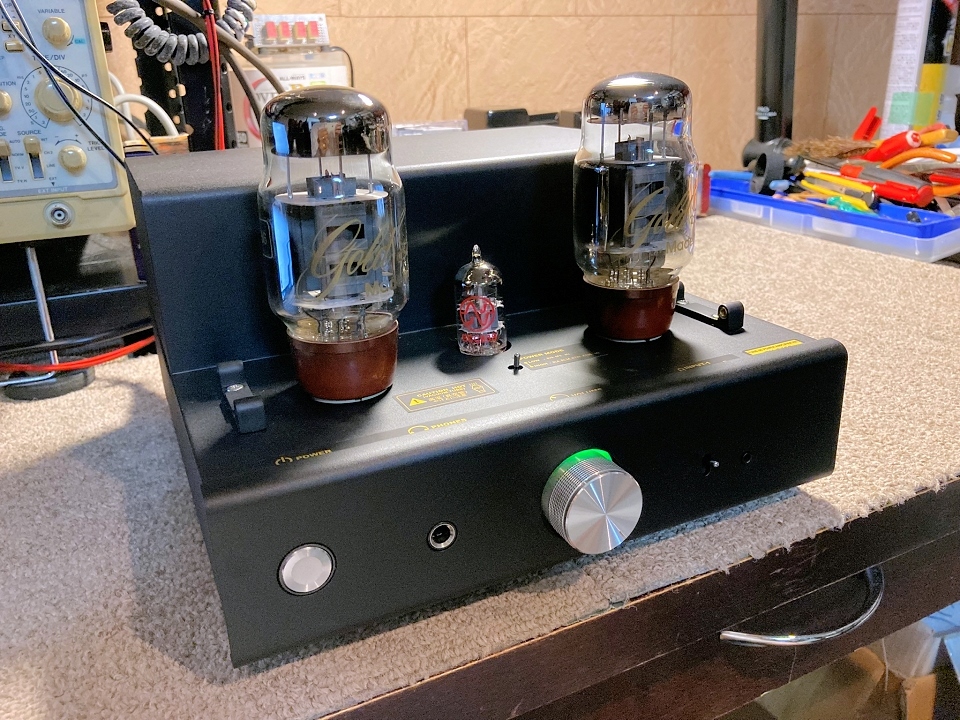
Gold Lion KT66
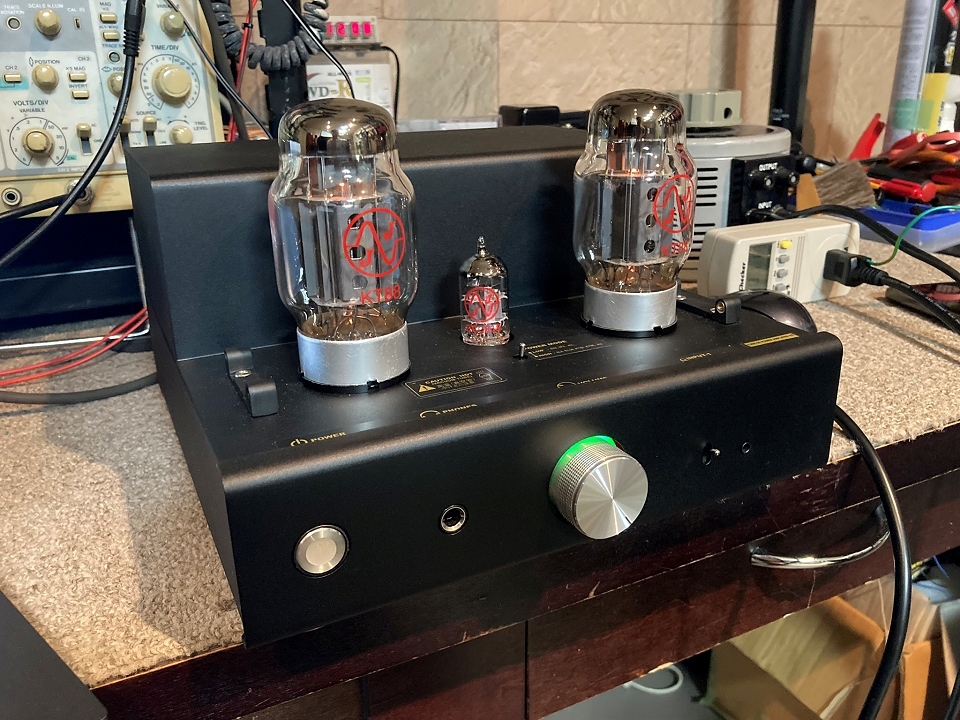
JJKT88
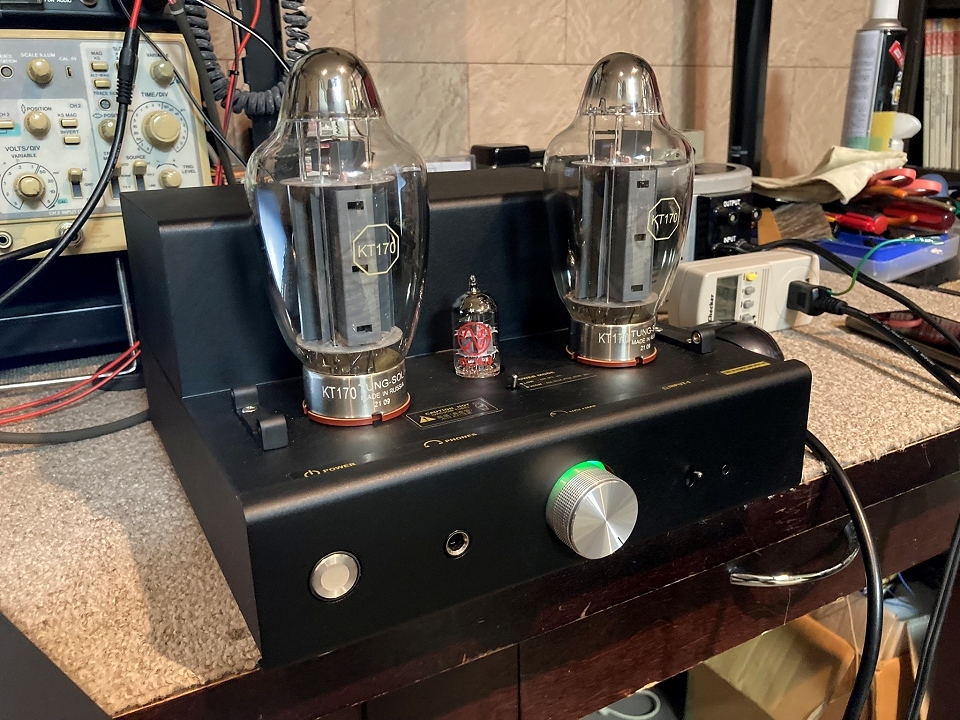
Tung Sol KT170
TU-8400 allows to use various output tubes without any adjustment. It is a great blessing not only for beginners but also for many Audio lovers'.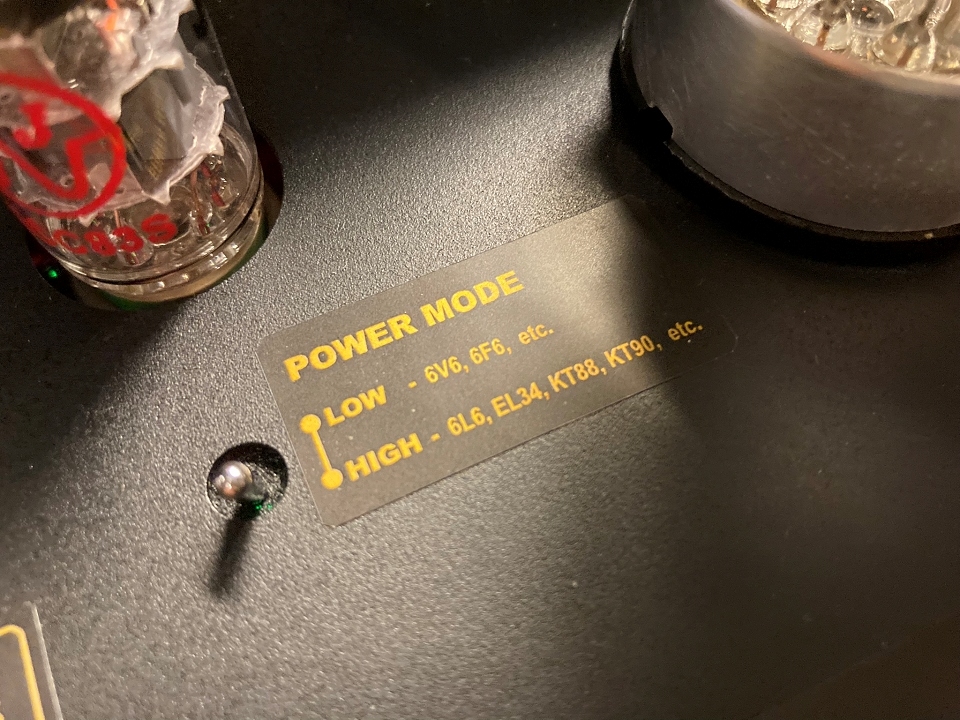
This is the HIGH/LOW Selector switch. HIGH mode is recommended for output tubes with plate loss of 6L6 or more, but if maximum output is not a priority, operation in LOW mode is also OK for sound quality reason.
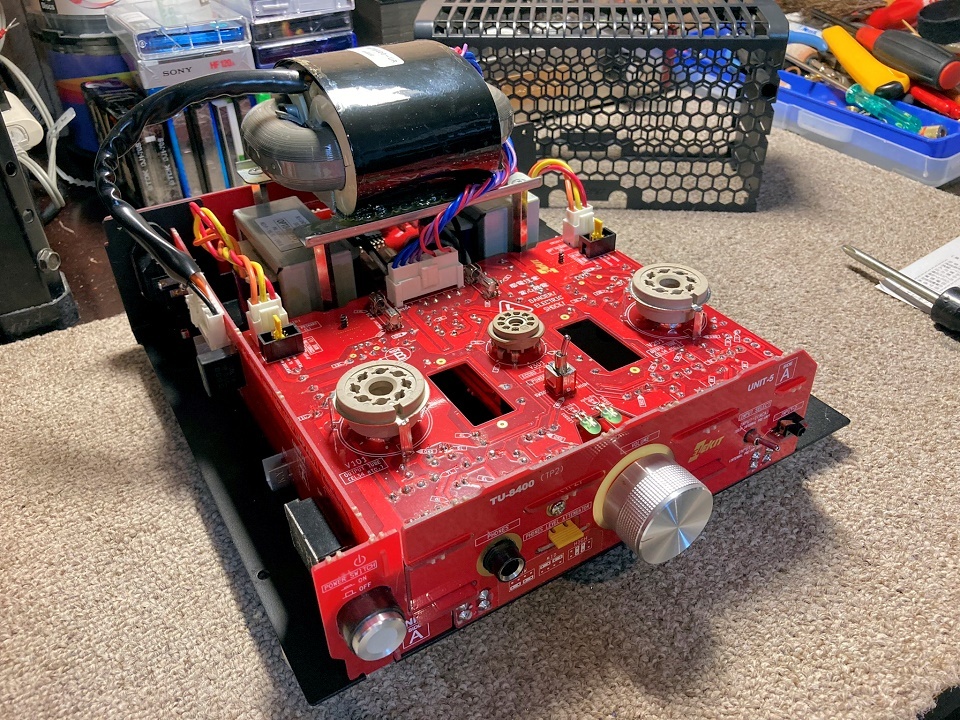
Let's open the chassis. The glass epoxy circuit board is assembled in a three-dimensional manner, which is a unique mechanical design that is unique to
ELEKIT.
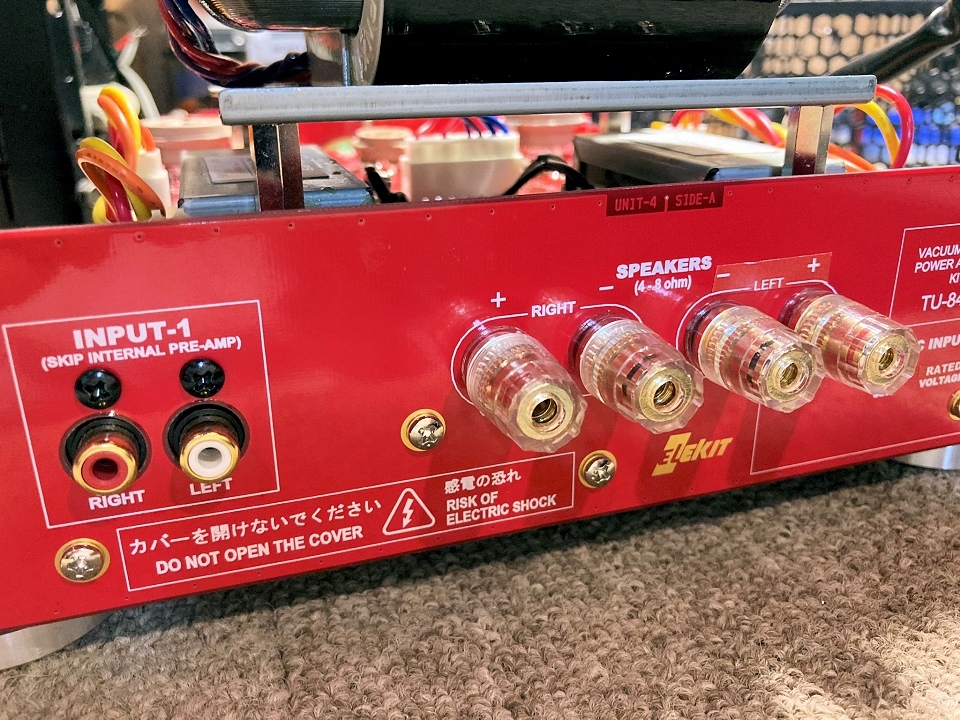
The rear panel also has input and output terminals directly attached to the board. The load impedance is 4 to 16 Ω (6 to 8 Ω recommended). I forgot to take a photo, but there is a dedicated stereo mini jack input on the front panel.
This INPUT2 has an op amp to increase the gain, which is a convenient function when using input devices with limited output voltage, such as portable music players.
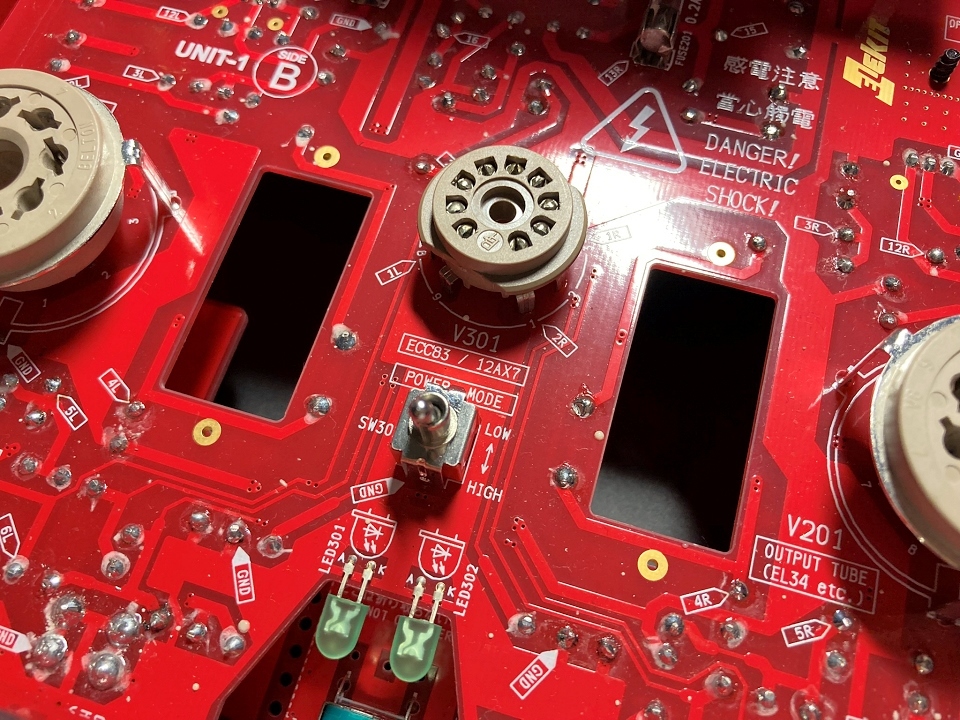
The TU-8400 also has space for upgrading coupling capacitors (0.1uf 630V X 2), proving that they are now recognized as the default solution for improving sound quality.
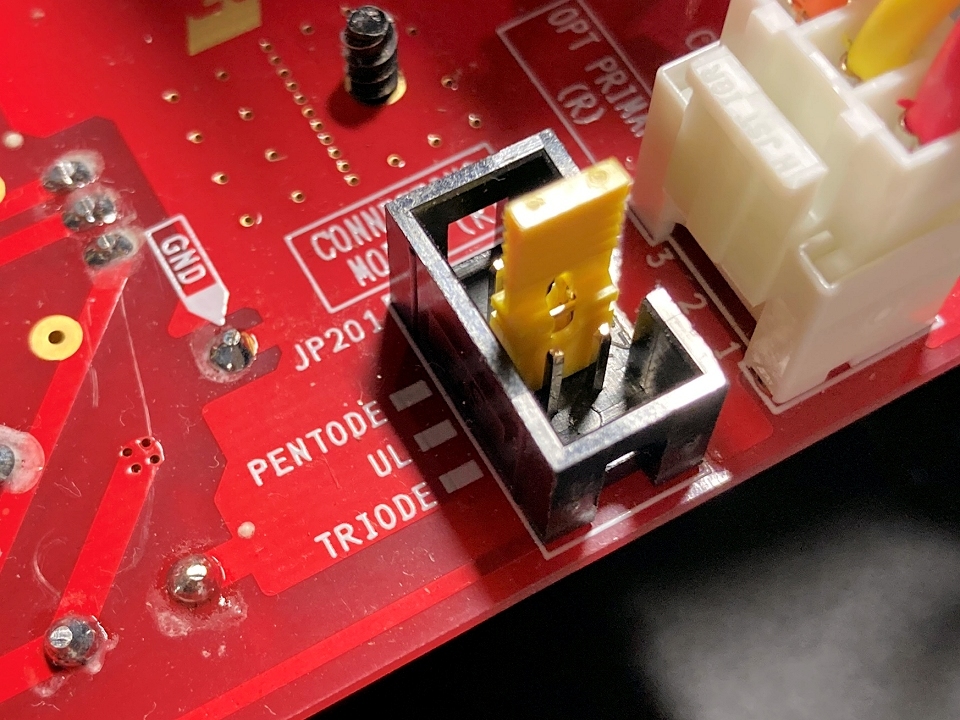
Another noteworthy feature is the ability to choose between PENTODE (pentode connection), UL (ultra-linear), and TRIODE (triode connection). UL is generally recommended from the standpoint of achieving both sound quality and output, but TRIODE is also an option when you want to listen to the delicate sound of triode mode, although the maximum output is halved.
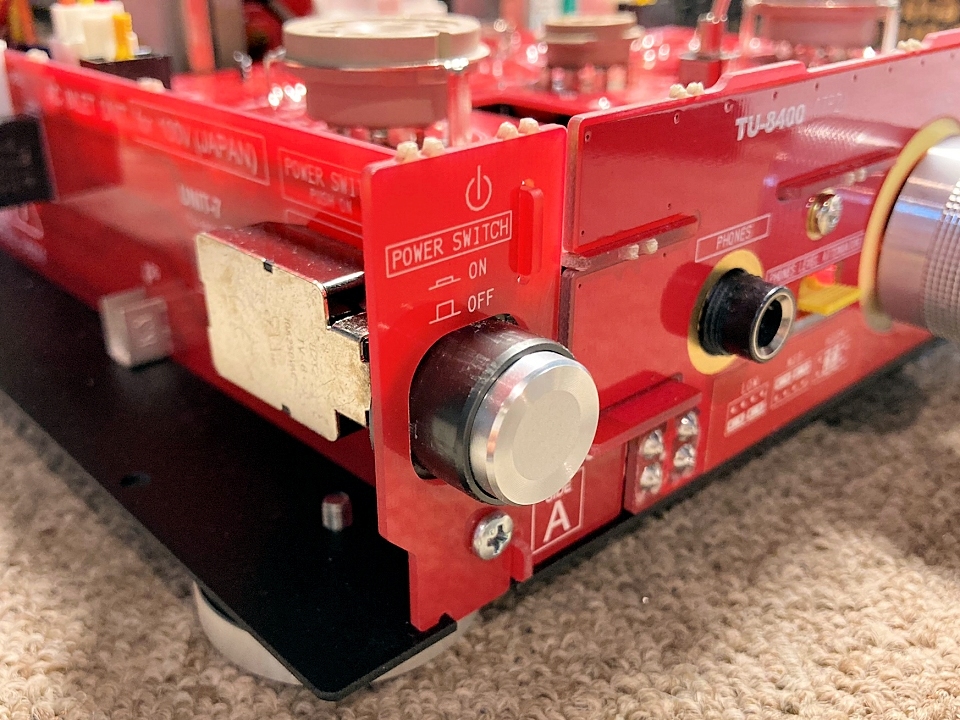
The power switch has been changed from the toggle switch on the TU-8200R to a push-type switch like the higher-end models.
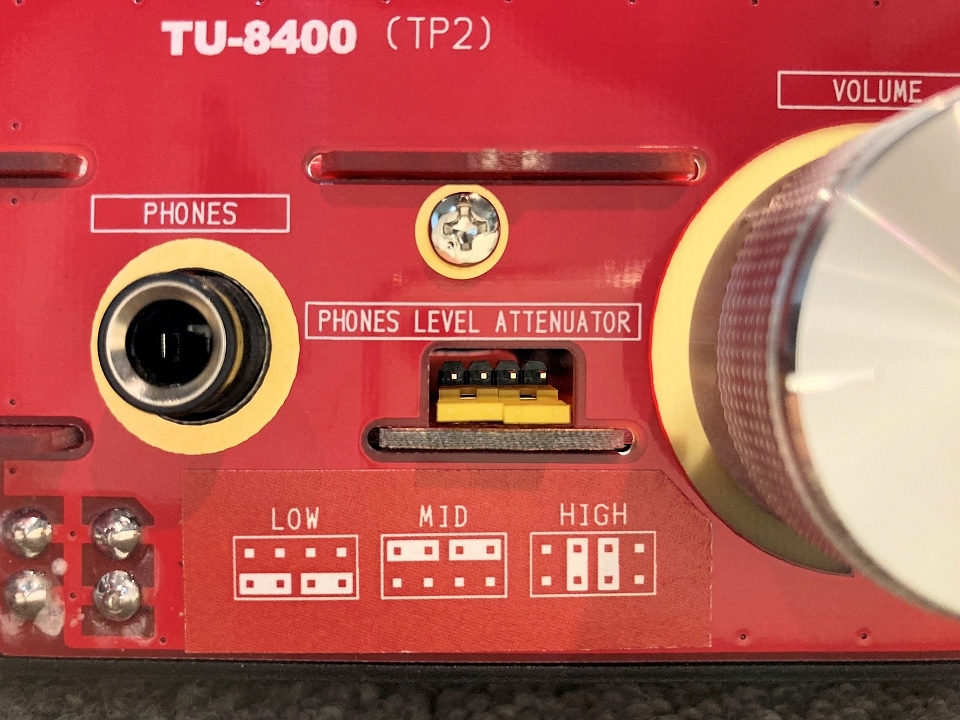
The headphone output is compatible with a standard 6.3mm diameter three-pole plug. Impedance is compatible with 8Ω to 600Ω. Since the gain changes depending on the impedance, three levels can be selected to select the optimal gain.
This is the end of the outline introduction. From here, we will begin to verify the electrical aspects' to comparison with the previous model, the TU-8200R (left). Although the coloring is different, it appears to be a successor model with many common external features, but after various measurements, we confirmed that the two are electrically very different.
*TU-8400 is a mass production prototype and may differ from the final product.
What I want you to pay attention to here is the gain. Comparing the TU-8400 and TU-8200R, there is a gain difference of about 12dB. 12dB may not make much sense, but in terms of voltage ratio, it is a difference of 4 times. As written in
the manufacturer's leaflet , the TU-8400 is designed to be used in conjunction with a preamplifier, and the design philosophy is fundamentally different from that of the TU-8200R. In other words, the TU-8400 is a product that has the potential to be developed into a separate product in the future, and for that reason, it can be understood that INPUT2, which has gain in gain with an OP amplifier, is provided as a backup.
Another point to note is the frequency characteristics. While the TU-8200R shows the typical frequency characteristics of a multi-electrode single tube, you will notice that the TU-8400 has a balance that leans more toward the low range. By the way, in terms of the output transformer, both the TU-8200R and the TU-8400 have a primary impedance of 3.5kΩ and are made by the same transformer manufacturer. It is just a guess, but I think that the low range is extended by increasing the primary inductance.
Now let's move on to the listening test.

First, I listened to the TU-8400 alone, then to the separate configuration with the addition of a preamp (SV-310). The output tubes were the Gold Lion KT66 and KT170 shown in the photo. The input used was input 1 (RCA) which does not go through an op amp.
The TU-8400 alone does not have the booming power of the TU-8200R, but has a smooth and delicate tone. The volume position is much higher than the TU-8200R, but if you have a speaker with an efficiency of 90dB or more, you will not feel stressed even when using it alone. Even at low volume, you can fully feel the solid scale of the support even when operating alone.
Next, when using TU-8400 with a preamplifier, a different character emerged. The low-frequency extension, which is a major characteristic of the TU-8400, is given a thicker sound, giving it a much more scale-like feel. As you may understand from the comparison table above, the TU-8400 has output tubes with larger plate losses, which means that TU-8400 is more efficient (less output loss). This result also makes it clear that the manufacturer's "premise of use with a preamplifier" is a given.
First enjoy it on its own, and then add a preamplifier as an upgrade someday...the TU-8400 is a perfect example of how to enjoy the improved quality of the playback sound. I would like to give my heartfelt applause to this new product from Elekit, which I would recommend to anyone looking to build their first unit or to anyone looking for their last unit.
Today I will report on Elekit's new product, the TU-8400, for which information has just been released by ELEKIT.
Thanks to the generosity of the manufacturer, we were able to borrow a mass-produced sample , which gave us the opportunity to thoroughly examine not only the features of this new model, but also the changes from the previous model (TU-8200R), and even compare the sound quality, so we would like to delve into this in more detail.

This is the TU-8400. The The black faceplate is very cool. It is a power amplifier with volume control and has one RCA input and one stereo mini plug input.
The auto-adjusting fixed bias circuit inherited from the TU-8200R allows you to enjoy adjustment-free switching with the same ease as a self-biasing amplifier. In addition, by switching the plate voltage between HIGH and LOW, it covers 6V6 and 6F6 in LOW mode, and 6L6 series, KT66, KT88, KT90, EL34, 5881, 7581, 6550, and even KT120, KT150, and KT170 in HIGH mode.
Let's start by looking at the exterior.

JJ EL34

Gold Lion KT66

JJKT88

Tung Sol KT170
TU-8400 allows to use various output tubes without any adjustment. It is a great blessing not only for beginners but also for many Audio lovers'.

This is the HIGH/LOW Selector switch. HIGH mode is recommended for output tubes with plate loss of 6L6 or more, but if maximum output is not a priority, operation in LOW mode is also OK for sound quality reason.

Let's open the chassis. The glass epoxy circuit board is assembled in a three-dimensional manner, which is a unique mechanical design that is unique to
ELEKIT.

The rear panel also has input and output terminals directly attached to the board. The load impedance is 4 to 16 Ω (6 to 8 Ω recommended). I forgot to take a photo, but there is a dedicated stereo mini jack input on the front panel.
This INPUT2 has an op amp to increase the gain, which is a convenient function when using input devices with limited output voltage, such as portable music players.

The TU-8400 also has space for upgrading coupling capacitors (0.1uf 630V X 2), proving that they are now recognized as the default solution for improving sound quality.

Another noteworthy feature is the ability to choose between PENTODE (pentode connection), UL (ultra-linear), and TRIODE (triode connection). UL is generally recommended from the standpoint of achieving both sound quality and output, but TRIODE is also an option when you want to listen to the delicate sound of triode mode, although the maximum output is halved.

The power switch has been changed from the toggle switch on the TU-8200R to a push-type switch like the higher-end models.

The headphone output is compatible with a standard 6.3mm diameter three-pole plug. Impedance is compatible with 8Ω to 600Ω. Since the gain changes depending on the impedance, three levels can be selected to select the optimal gain.
This is the end of the outline introduction. From here, we will begin to verify the electrical aspects' to comparison with the previous model, the TU-8200R (left). Although the coloring is different, it appears to be a successor model with many common external features, but after various measurements, we confirmed that the two are electrically very different.

*TU-8400 is a mass production prototype and may differ from the final product.
What I want you to pay attention to here is the gain. Comparing the TU-8400 and TU-8200R, there is a gain difference of about 12dB. 12dB may not make much sense, but in terms of voltage ratio, it is a difference of 4 times. As written in
the manufacturer's leaflet , the TU-8400 is designed to be used in conjunction with a preamplifier, and the design philosophy is fundamentally different from that of the TU-8200R. In other words, the TU-8400 is a product that has the potential to be developed into a separate product in the future, and for that reason, it can be understood that INPUT2, which has gain in gain with an OP amplifier, is provided as a backup.
Another point to note is the frequency characteristics. While the TU-8200R shows the typical frequency characteristics of a multi-electrode single tube, you will notice that the TU-8400 has a balance that leans more toward the low range. By the way, in terms of the output transformer, both the TU-8200R and the TU-8400 have a primary impedance of 3.5kΩ and are made by the same transformer manufacturer. It is just a guess, but I think that the low range is extended by increasing the primary inductance.
Now let's move on to the listening test.
First, I listened to the TU-8400 alone, then to the separate configuration with the addition of a preamp (SV-310). The output tubes were the Gold Lion KT66 and KT170 shown in the photo. The input used was input 1 (RCA) which does not go through an op amp.
The TU-8400 alone does not have the booming power of the TU-8200R, but has a smooth and delicate tone. The volume position is much higher than the TU-8200R, but if you have a speaker with an efficiency of 90dB or more, you will not feel stressed even when using it alone. Even at low volume, you can fully feel the solid scale of the support even when operating alone.
Next, when using TU-8400 with a preamplifier, a different character emerged. The low-frequency extension, which is a major characteristic of the TU-8400, is given a thicker sound, giving it a much more scale-like feel. As you may understand from the comparison table above, the TU-8400 has output tubes with larger plate losses, which means that TU-8400 is more efficient (less output loss). This result also makes it clear that the manufacturer's "premise of use with a preamplifier" is a given.
First enjoy it on its own, and then add a preamplifier as an upgrade someday...the TU-8400 is a perfect example of how to enjoy the improved quality of the playback sound. I would like to give my heartfelt applause to this new product from Elekit, which I would recommend to anyone looking to build their first unit or to anyone looking for their last unit.
Last edited:







